Time tracking tools should help you stay organized, not slow you down. Jibble works for many people, but it might not be the best fit for everyone. Maybe you need different features, an easier setup, or just want to try something new.
In this blog, I’ve put together a list of 10+ Jibble alternatives you can check out in 2025. Each one has something a little different to offer, so you can find the right tool for your team and the way you work. Let’s get into it.
Why Users are Picking New Tools Over Jibble
Jibble gets the job done for many teams, but it doesn’t always offer the flexibility some users need. A frequent complaint is the area of reports, which is excellent, but not a lot of customization over filters and creating new views, which can be restricting when you want more detailed information.
There are also a few small issues that come up during daily use. The mobile app is not always as up-to-date as the web version, and not all features such as facial recognition, are functional during poor lighting or when the camera is blurred. These issues are not critical, but they may make things move more slowly or create additional inconvenience.
Another area where teams run into trouble is offline use. It allows clocking in without the internet, but you cannot switch tasks or take breaks until you are online again. Combined with a bit of a learning curve for advanced features, these things can add up, and that’s when some teams start looking for tools that feel a little more flexible and reliable.
Key Features of Jibble
- Kiosks have a speed mode that enables several team members to clock in using a single tablet or mobile device, which saves time during peak shifts.
- Flexible timesheets are simple, understandable, and completely calculated - they are right in your phone, so you can access them and make changes quickly.
- Live location tracking allows you to see where team members are in real-time across the day.
- Face recognition simplifies clocking in and is safe and secure - employees can clock in with their face on a personal device or a shared kiosk, which guarantees the correct attendance.
Drawbacks of Jibble
1. Complex User Interface
The interface of Jibble has been considered to be a bit daunting by several users, particularly when it comes to manually logging time. New users often mention a learning curve and feel the UI could be made simpler and more intuitive.
2. Auto-Logout
The automatic logout feature has been frustrating for some, as it can log users out too quickly during short periods of inactivity, even when they're on a break. Sometimes, this interrupts workflows and requires frequent re-logins.
3. Mobile App Performance Issues
Although the mobile app is mostly stable, it has had some issues of lagging or taking time to sync with the web platform. At times, the app crashes and requires a manual restart to work.
4. Syncing Inconsistencies
Some users have complained about the inaccuracy of the sync between the app and the site. This led to time entries being missed or needing to be entered manually, causing extra work for admins or HR teams.
5. Unreliable Internet Conditions
In locations where the internet is unstable, the performance of Jibble may decrease, and the punch-ins may not register correctly. This causes confusion in teams and may lead to errors that must be corrected manually at a later stage.
Top 10 Jibble Alternatives You May Have Missed
1. Time Champ
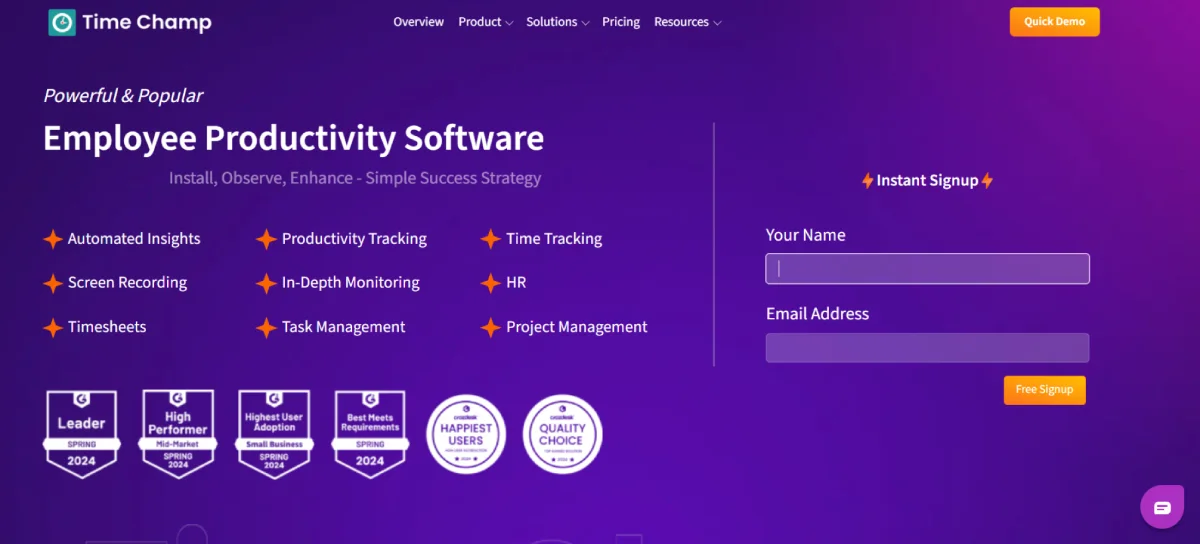
Time Champ is a feature-rich time-tracking and productivity software built to support hybrid, remote, and on-site teams with detailed visibility into daily workflows. It automatically tracks tasks as soon as employees select or start them, supports recurring task setups, and allows manual time entries when needed.
Time Champ also offers employee activity monitoring such as keystroke logging , screenshots, audio tracking, and location monitoring, delivering real-time insights and automated alerts to detect idle time, improve accountability, and help managers spot productivity bottlenecks. With robust integrations, flexible reporting, attendance and scheduling tools, and support for detailed payroll-ready analytics via its API and dashboard interface, Time Champ is designed to streamline task management , enhance collaboration, and boost productivity through real-time insights and automation.
Key Features
- Office TV feature provides live access to the screen, so managers can immediately know what employees are currently working on.
- Project management provides an easy way to allocate tasks, monitor objectives, plan sprints, handle bugs, calendars, and resource allocation using a centralized dashboard.
- Employee monitoring allows you to view live screens, capture screenshots, and record sessions based on your needs.
- Moonlight detection helps identify secondary job activity by detecting unusual work patterns, with customizable settings to align with company policies .
- Time tracking automatically records work hours, generates timesheets , and supports both online and offline tracking.
| Pros | Cons |
|---|---|
| Real-time monitoring with screenshots and screen recording | Occasional sync delays and app crashes |
| Easy-to-use interface with quick setup | App may not start automatically on some devices |
| Accurate time, attendance, and geolocation tracking | Accurate time, attendance, and geolocation tracking |
| All-in-one dashboard for projects, tasks, and productivity reports |
Pricing
- Starter: $3.9/user/month
- Professional: $6.9/user/month
- Enterprise: $13.9/user/month
Ratings
- G2: 4.8
- Capterra: 4.9
2. Deputy
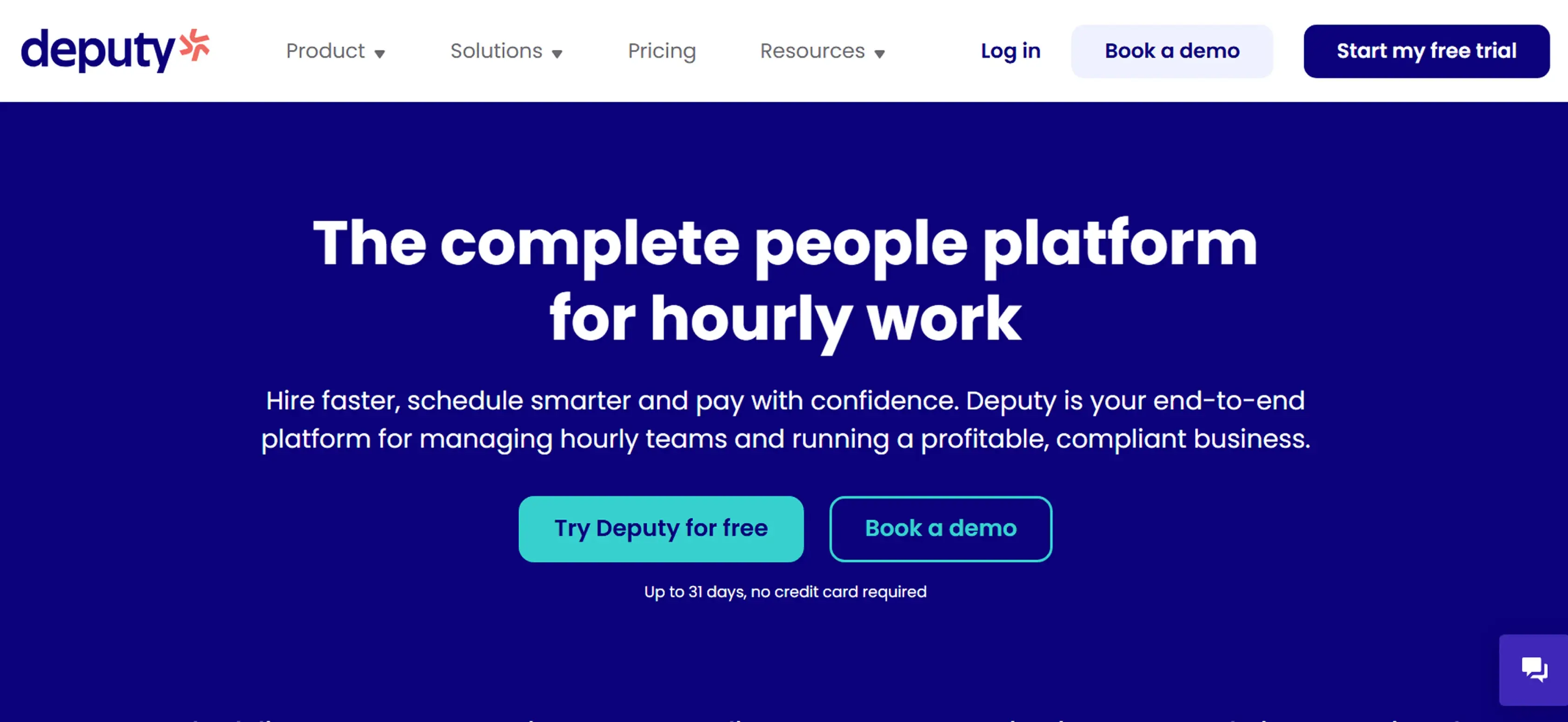
Deputy is a workforce management tool with integrated features, commonly used in retail, hospitality, and healthcare industries. It provides an easy shift schedule using drag-and-drop and auto-scheduling AI, and precise time tracking using mobile devices, tablets, desktops, and facial recognition kiosks. Users benefit from automatic timesheets, payroll integrations, leave and task management, compliance tools for breaks and labor laws, and in-app communication features such as a newsfeed and shift swap alerts.
Key Features
- Auto-scheduling assigns the right staff at the right times by factoring in availability, training, and labor hour limits, while keeping wage costs within the budget .
- Touchless clock-in allows employees to check in and out with face recognition or voice commands via the kiosk or tablet app.
- Break management helps schedule meal and rest breaks efficiently, maintain service coverage, and ensure compliance with labor laws.
- Leave management streamlines PTO and time-off tracking with customizable settings, and mobile-friendly requests and approvals.
| Pros | Cons |
|---|---|
| Reliable and easy-to-use app for scheduling and time tracking | Holiday/leave requests don’t always process smoothly |
| Syncs shifts to personal calendars for better planning | Occasional mobile app crashes or sync delays |
| Clear visibility into schedules, shifts, and timesheets via mobile | Some users experience too many push notifications |
| Accurate time calculation and flexible reporting options |
Pricing
Monthly:
- Scheduling: $4.50/user/month
- Time and Attendance: $4.50/user/month
- Premium: $6/user/month
- Enterprise : custom
Yearly:
- STANDARD: $2.50 per user/month
- ELITE: $3.50 per user/month
Ratings
- G2: 4.6
- Capterra: 4.6
3. Toggl Track
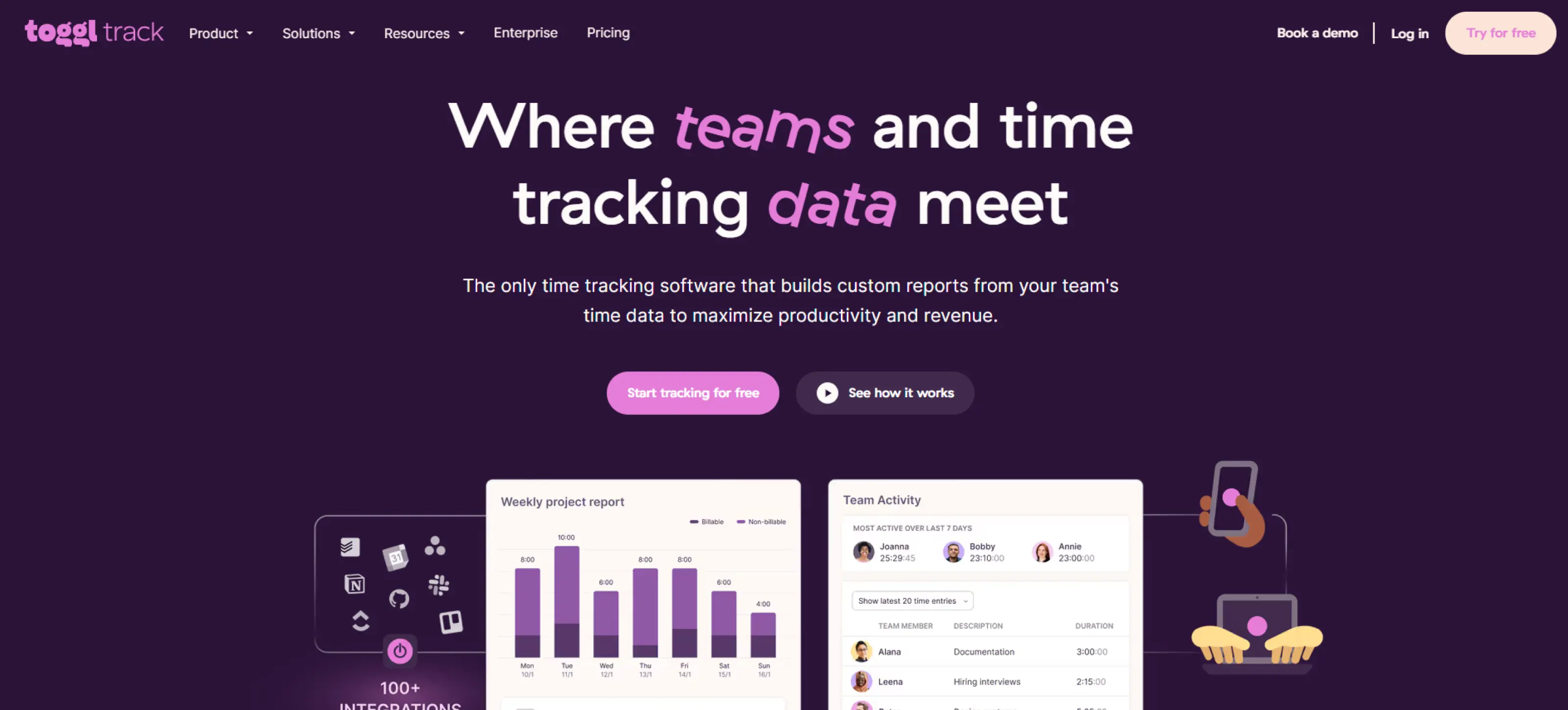
Toggl Track is a time tracking solution that helps freelancers, teams, and businesses find easy and flexible solutions to track work hours. It provides single-click timers, manual time entries, and calendar integrations, and users can track time on any device, even when they are offline. Supporting detailed project- and client-based reports,billable hours, and exportable data are used to create invoices or analysis. With integrations for tools like Asana, Slack, and Trello, Toggl Track fits into various workflows.
Key Features
- Idle time alerts inform users of idle or off keyboard time and give the choice to discard or log idle time as a separate entry.
- One-click timers allow users to begin to track time on certain projects or clients within any app instantly, with the ability to edit later.
- Offline tracking allows users to record time without internet access and sync it later, supporting both manual and timer-based modes.
- Personal overview offers a calendar timeline that visualizes activity levels in 15-minute segments or dynamic intervals based on real-time usage.
| Pros | Cons |
|---|---|
| Simple and intuitive interface, easy for new users to get started. | Some syncing and interface inconsistencies across devices. |
| Works well across web, mobile, and desktop platforms. | Linux support is limited, and the mobile experience is less robust than web. |
| Helpful features like reminders, offline mode, and detailed reports. | Analytics and filters can be confusing for some users. |
| Good for tracking time across multiple projects and clients. |
Pricing
- Free : $0 Free for up to 5 users.
- Starter: $9 per user per month.
- Premium: $18 per user per month.
Ratings
- G2: 4.6
- Capterra: 4.7
4. Harvest
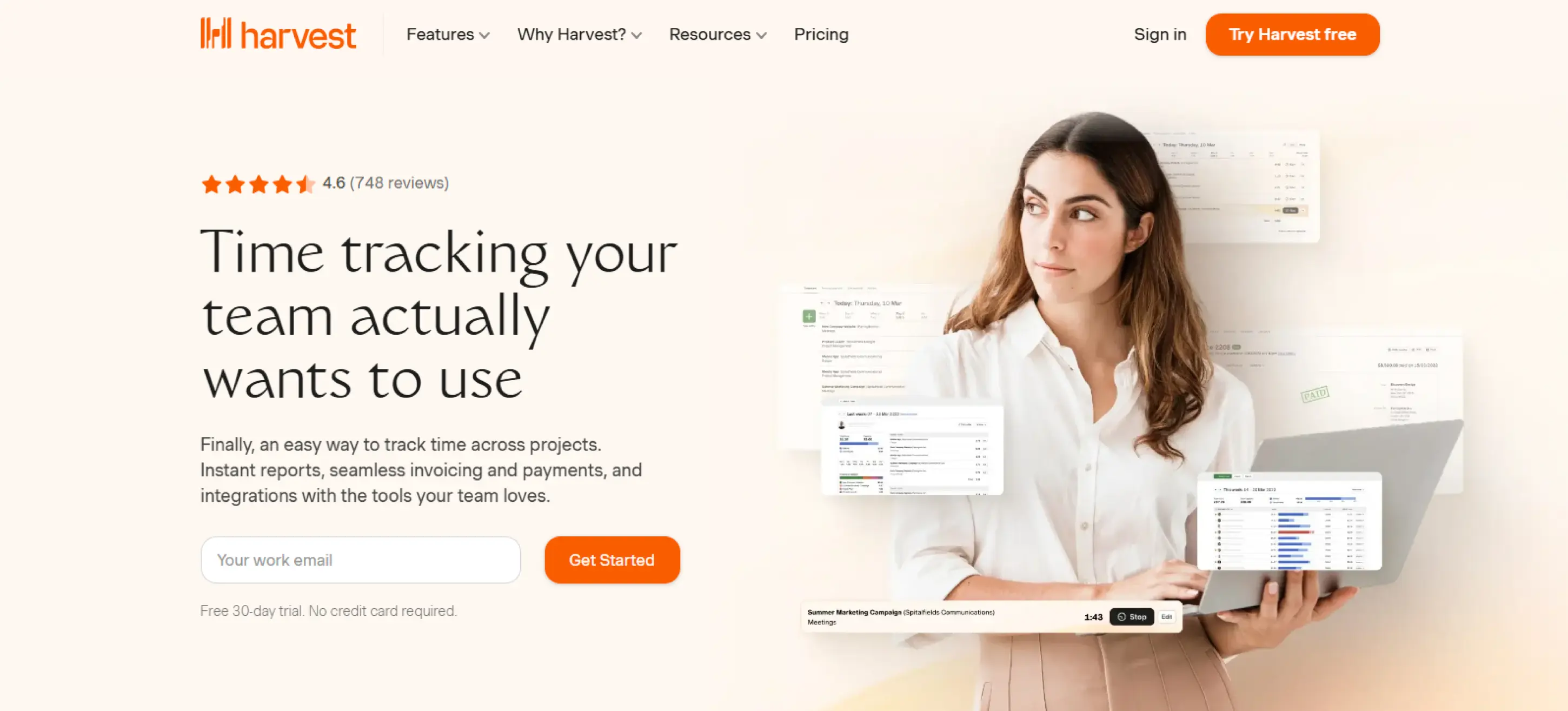
Harvest is a simple time tracking software that helps teams and freelancers track time, manage expenses, and send invoices, all in one place. It has one-click timers, manual entry and expense logging, with configurable reporting that breaks down billable and non-billable hours, project budgets, and team performance . Through its in-built invoicing features, users can turn the tracked hours and expenses into professional invoices and even collect payments online, through services such as Stripe and PayPal.
Key Features
- Project reporting enables you to track budgets and costs to have a better picture of project profitability.
- Project management enables you to set financial limits, track ongoing spending, and notify your team as budgets get near their thresholds.
- Time management gives your team insight into how their time is used, helping improve productivity and maintain healthy work habits.
- Invoicing turns tracked billable hours into ready-to-send online invoices, streamlining the billing process.
| Pros | Cons |
|---|---|
| Simple, intuitive interface for time tracking and invoicing. | Lacks advanced features like AI and dashboards. |
| Works across desktop, mobile, and browser. | Pricey for small teams with limited lower-tier features. |
| Allows real-time tracking and manual edits. | Project setup can get confusing with many clients. |
| Easy-to-send, customizable invoices. |
Pricing
- Free: $0 free forever
- Pro : $11/ per seat/month
- Premium: $14/per seat/month
Ratings
- G2: 4.3
- Capterra: 4.6
5. Intervals
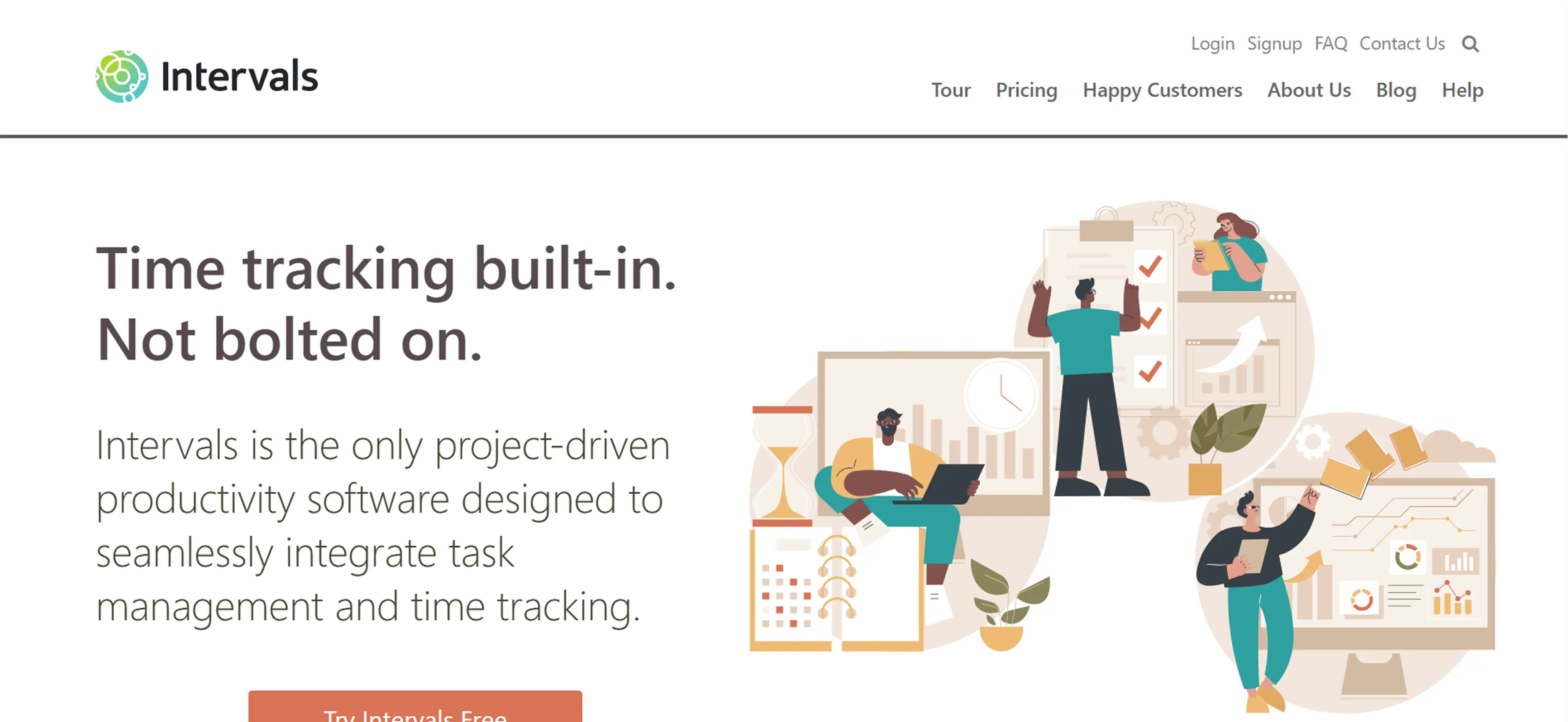
Intervals is a web-based project management and time tracking tool designed for small teams. It provides features such as task management, time tracking, reporting, and invoicing, with the primary emphasis on client work management and billable hours. The platform integrates project planning and execution tools into a single interface, and they can be customized. It is mainly targeted at service-based companies, which want to monitor project status and team performance.
Key Features
- Time tracking enables users to log billable hours with simple, intuitive timers, helping teams accurately capture time.
- Task management keeps team members aligned by organizing tasks in a central space, supporting streamlined collaboration and progress tracking.
- Reporting tools generate clear, customizable insights, allowing users to quickly access data and make informed project decisions.
- Project management simplifies workflows through visual dashboards and configurable processes, reducing administrative work.
| Pros | Cons |
|---|---|
| Easy to use and accessible for small to medium businesses. | Interface can be overwhelming and outdated. |
| Efficient time tracking and task management features. | Steep learning curve for new users. |
| Cloud-based access allows flexibility for remote teams. | Limited customization in reporting and workflows. |
| Allows detailed tracking by tasks, milestones, and budgets. |
Pricing
- Basic: $49/month
- Professional: $99/month
- Unlimited: $299/month
Ratings
- G2:--
- Capterra: 4.4
6. Connecteam
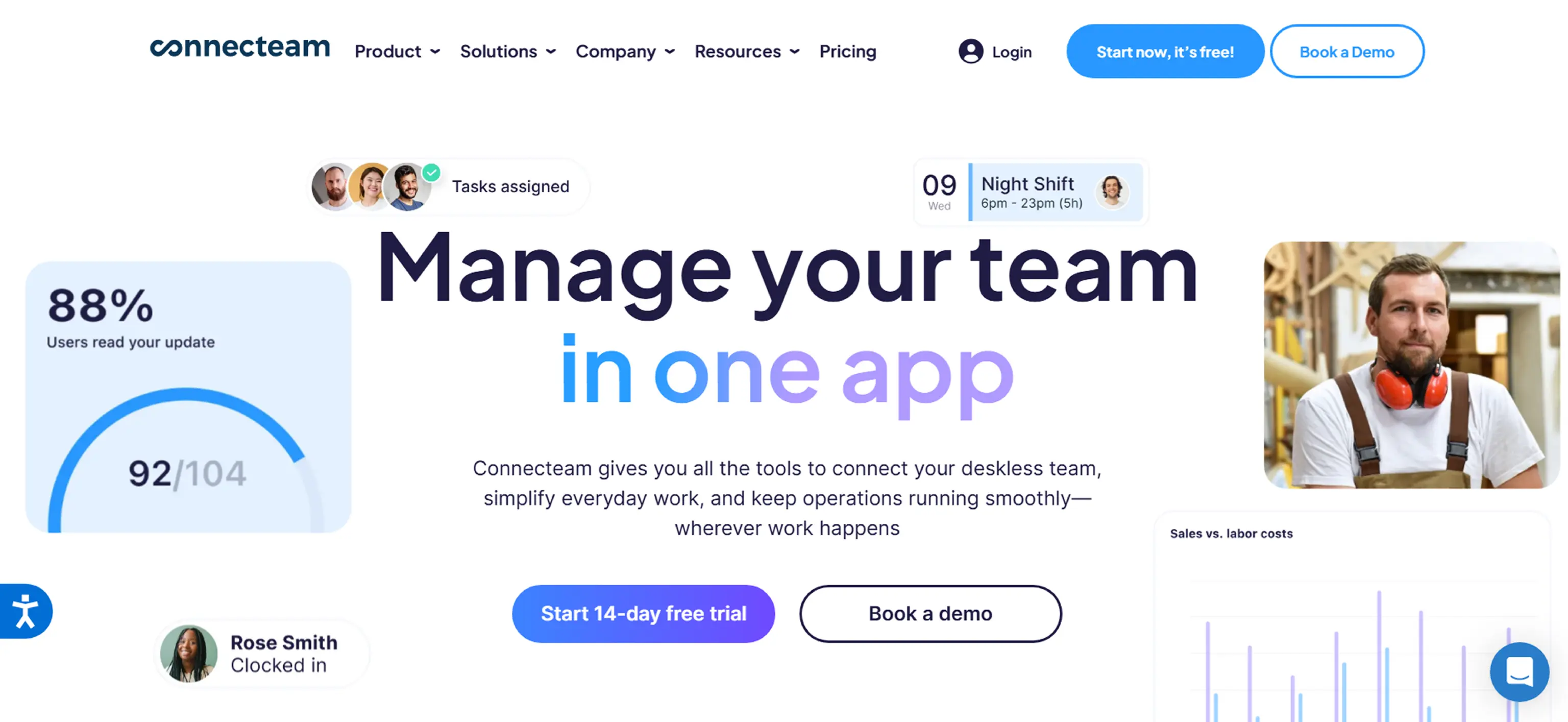
Connecteam is a workforce management tool that enables companies to manage their non-desk workforce using features such as scheduling, time tracking, communication, and task management. It provides a mobile-first interface targeting the retail, construction, and healthcare industries. The platform includes tools for employee engagement , operations, and HR processes, aiming to centralize workforce coordination in one app.
Key Features
- Task management puts all tasks and projects under one roof, ensuring that non-desk teams can be easily coordinated.
- Timeline tracking gives insight into the milestones, performance, and development of employees that helps in workforce evaluation and planning.
- Scheduling lets managers create and distribute employee schedules instantly, helping ensure coverage and smooth shift operations.
- Time clock allows employees to clock in and out using a mobile app or on-site kiosk, with optional geo-fencing to ensure accurate location-based tracking.
| Pros | Cons |
|---|---|
| Intuitive and user-friendly app and dashboard. | Occasional glitches and syncing issues with clock-in/out. |
| Efficient time tracking with geolocation and scheduling tools. | Users cannot set personal time zones in profiles. |
| Good for remote teams and mobile-first workforces. | Time-off and scheduling rules can feel restrictive. |
| Helpful reminders, notifications, and real-time updates. |
Pricing
- Basic: $29/month (for 30 users)
- Advanced: $49/month (for 30 users)
- Expert: $99/month (for 30 users)
- Enterprise: Custom
Ratings
- G2: 4.6
- Capterra: 4.6
7. Timely
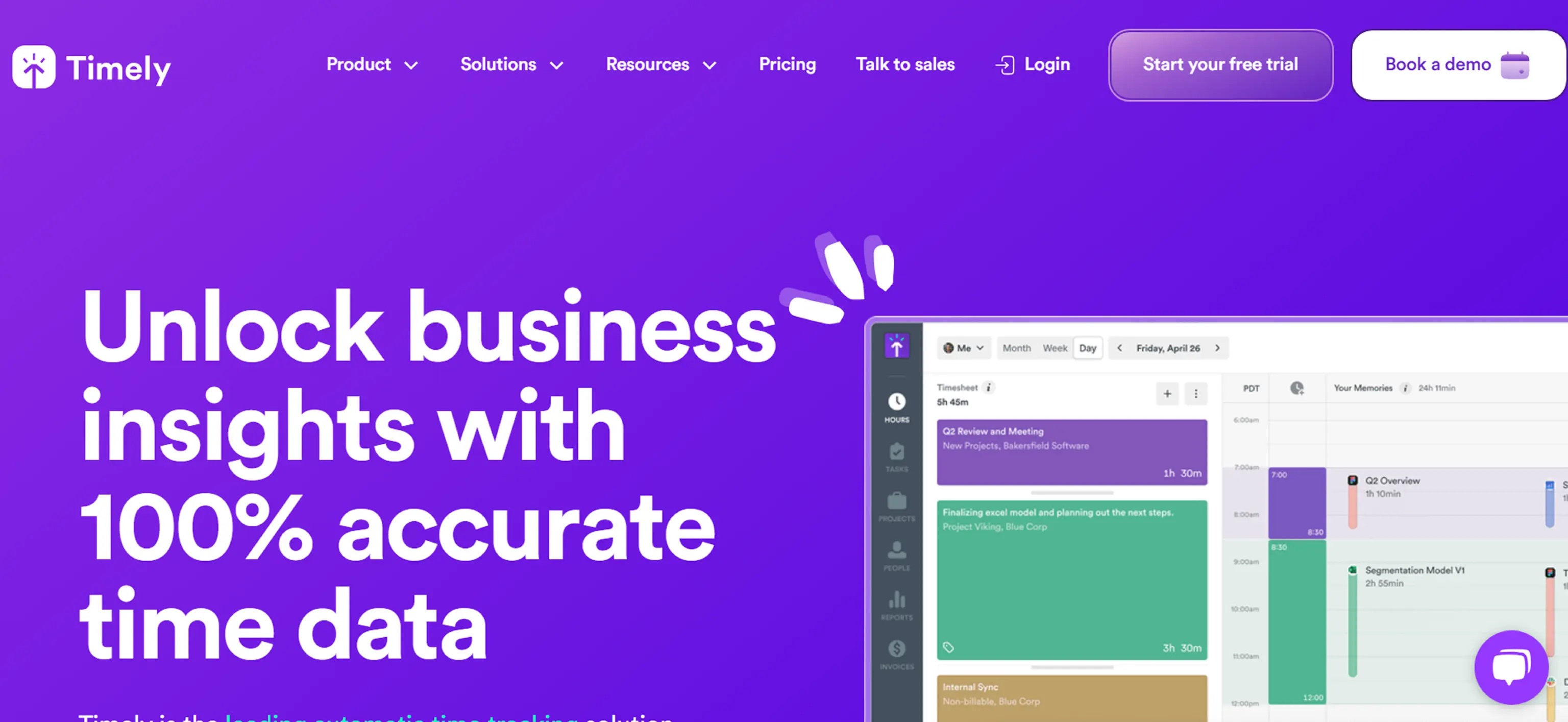
Timely is an auto-time tracking software that assists individuals and teams to record work hours without any manual work. It uses artificial intelligence to track activities across devices and organizes them into categorized timesheets. Features like project tracking, team scheduling, and reporting are aimed at improving team management and visibility across workloads. Timely is used by freelancers, agencies and businesses who want an easier way to track time.
Key Features
- People dashboard offers an up-to-date overview of team capacity and workload, which allows the management to allocate resources more effectively and minimize the danger of employee burnout .
- AI timesheets can automatically monitor work hours based on user activity and allow the creation of timesheets in a short period with minimum manual intervention.
- Planned time is used to predict work, track scheduled and actual hours, and assist in making more informed project decisions to keep schedules and budget in control.
- Employee scheduling helps to handle shifts, time off, and availability easily.
- Project dashboard offers up-to-date insights into project status, budget usage, and timelines, helping teams stay organized and on track.
| Pros | Cons |
|---|---|
| Clean, user-friendly interface for easy setup and onboarding | Mobile app lacks depth and can be slow at times |
| Real-time project and budget tracking with billable rate support | Higher pricing may not suit small teams or freelancers |
| Strong integrations with calendars and project tools | Doesn’t always auto-capture activity accurately |
| Visual, customizable reports for transparency and insights |
Pricing
- Starter: $9/user/month/yearly
- Premium: $16/user/month/yearly
- Unlimited: $22/user/month/yearly
- Enterprise Custom
Ratings
- G2: 4.8
- Capterra: 4.7
8. Time Camp
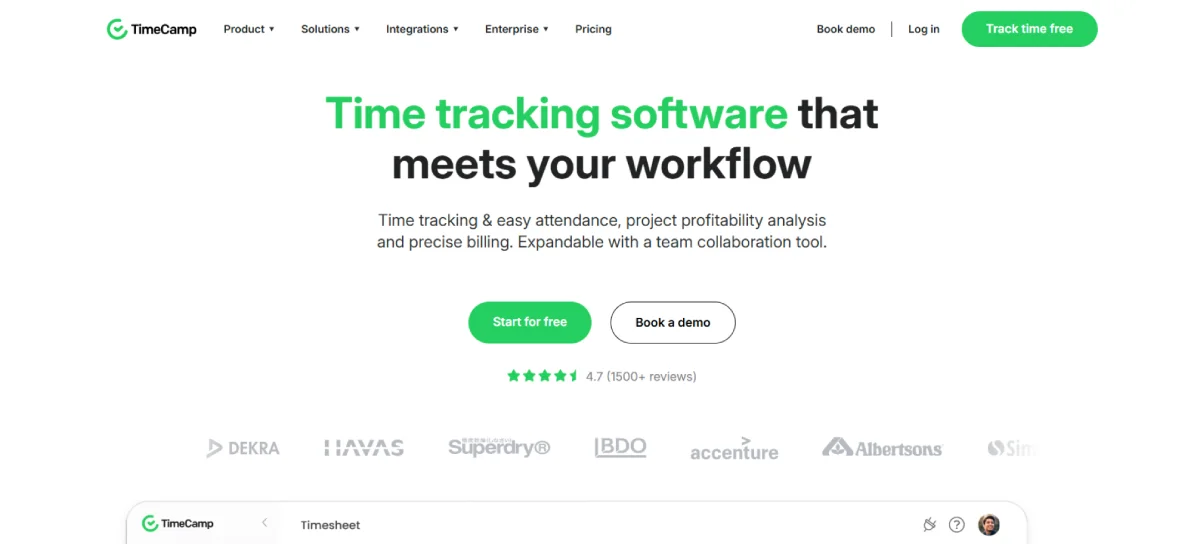
TimeCamp is a cloud-based time tracking tool that provides both manual and automated time tracking on the web, desktop, and mobile devices. It also integrates well with tools such as Asana, Trello, Slack, QuickBooks, and Xero, making it possible to manage tasks and work hours effectively. It has features such as automatic tracking, customizable timesheets and reports, billable and non-billable time tracking, invoicing, and attendance tracking via GPS and geofencing. The platform supports unlimited users and projects on its free plan, while paid plans provide additional tools for billing, reporting, and compliance with data privacy standards.
Key Features
- One-click timesheet feature enables simple time tracking via a simple start/stop interface and allows fast and precise work hours to be recorded.
- Budget planning tools enable users to make time and cost estimates of projects and tracking the progress in real-time to prevent overruns and stay financially in control.
- Automated invoicing creates client-ready invoices directly out of billable time, so that it can be billed accurately and transparently and based on the time recorded.
- Keyword-based time tracking automates task logging by identifying user-defined terms in activities, reducing manual input and improving task categorization.
| Pros | Cons |
|---|---|
| Accurate time tracking with calendar view and task tagging | Sync issues between desktop and mobile |
| Integrates with Trello, Monday.com, QuickBooks, and iCalendar | Timer delay on desktop can be misleading |
| Flexible manual entry and billing support | Manual entry in browser is buggy and confusing |
| User-friendly interface, quick setup, and responsive support |
Pricing
- Starter: $1.49/user/annually
- Premium:$2.99/user/annually
- Ultimate: $3.99/user/annually
- Enterprise: $11.99/user/annually
Ratings
- G2: 4.7
- Capterra: 4.7
9. Homebase
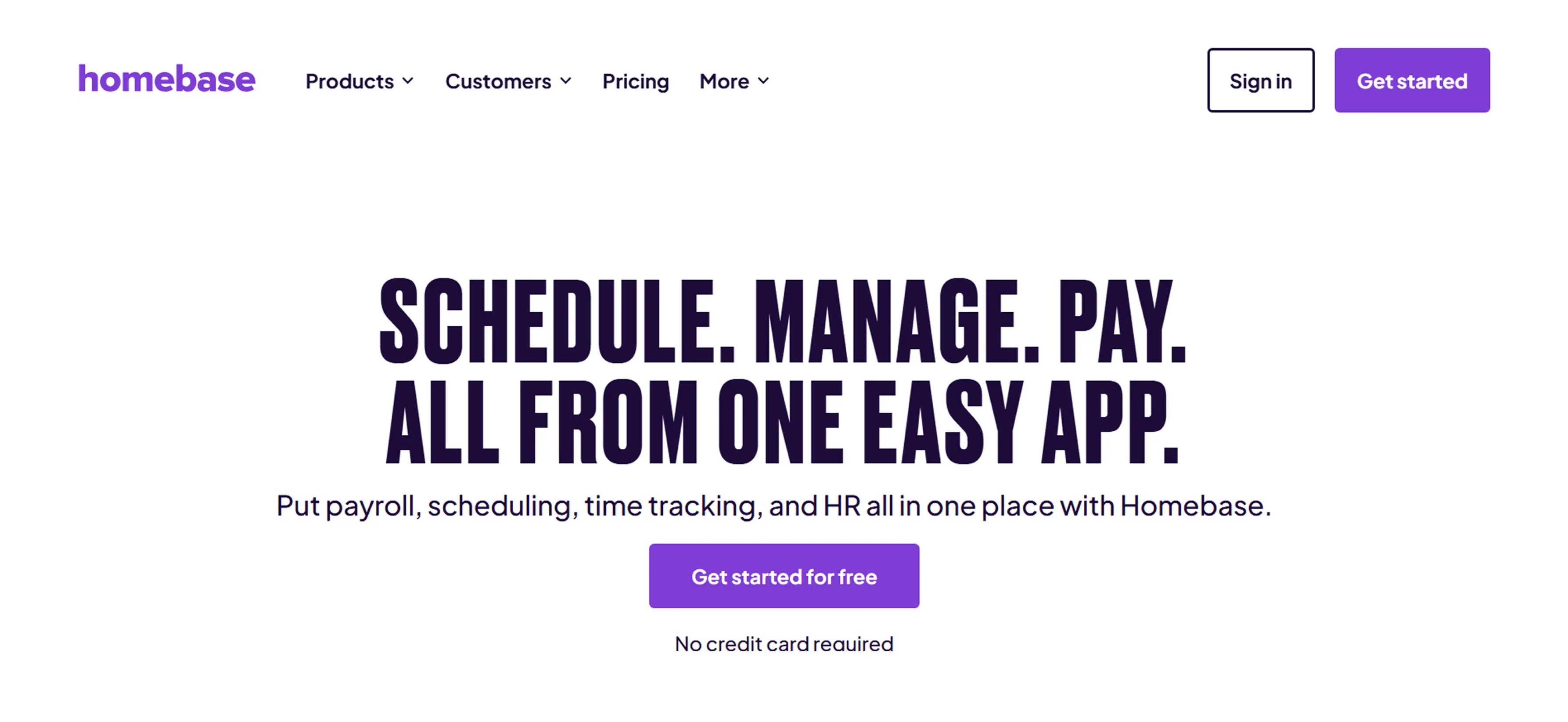
Homebase is a workforce management platform designed for small businesses with hourly employees, offering tools for scheduling, time tracking, payroll, team communication, and basic HR functions. It has features such as mobile, kiosk-based time clocks with GPS and PIN authorization, automatic time and breaks computation, and simplified payroll. The scheduling tool supports drag and drop scheduling, templates, labor cost estimations and shift notifications. It also offers dashboards to track labor costs, productivity and compliance and in-app messaging to coordinate teams.
Key Features
- Timesheet management automates hours, breaks, overtime, to create accurate payrolls with various wage rates.
- HR and compliance capabilities assist in storing sensitive employee data, assist new employees in online self-onboarding, and make it easier to manage documents to minimize administrative burden.
- Clock-in and out functionality records hours, breaks, and PTO without manual data entry, and works across various devices, including smartphones, tablets, computers, and POS systems.
- Scheduling tools allow managers to publish or update shifts with instant notifications via text and email, along with automatic shift reminders to reduce no-shows.
| Pros | Cons |
|---|---|
| Free plan with generous features for small businesses | App can be glitchy when clocking in/out or syncing data |
| Mobile app for clock-in/out, messaging, and time-off requests | Notifications may be excessive or inconsistent |
| Real-time labor cost projections and payroll integration | Slower performance for international users |
| Seamless POS integration and geofencing options |
Pricing
- Basic: $0
- Essentials: $24/month/unlimited employees
- Plus: $56/month/unlimited employees
- All-in-One: $96/month/unlimited employees
Ratings
- G2: 4.3
- Capterra: 4.6
10. Insightful
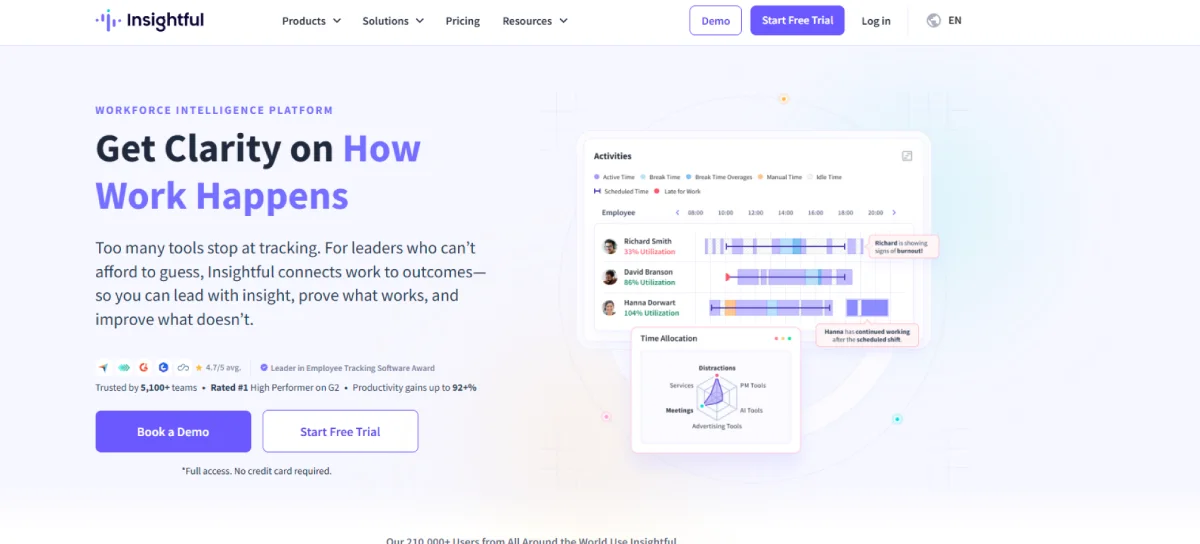
Insightful (formerly Workpuls) is a workforce analytics and employee monitoring platform that quietly runs in the background on Windows and macOS devices, capturing app and website usage, active versus idle time, and optional screenshots. It automatically maps activities into detailed timesheets and productivity dashboards, offering organizations real-time visibility into how work gets done and enabling data-driven decisions and workflow optimization. Overall, it provides deep insight into digital workforce performance while demanding thoughtful setup.
Key Features
- App and website usage tracking gives visibility on the digital tools and sites accessed by employees, and this data could be viewed at individual, team, or company level.
- Screenshot monitoring takes a random or action-based picture to aid in identifying suspicious or malicious activity in the workplace.
- Activity tracking logs active versus idle time and allows for review and approval of manual time entries.
- Stealth mode enables discreet monitoring to help detect policy violations or unusual behavior.
| Pros | Cons |
|---|---|
| Accurate tracking of time, tasks, and idle activity | Some users experienced bugs, sync issues, or app crashes |
| Simple and intuitive UI, easy for non-tech users | Lacks advanced reporting and auto-calculation features |
| Productivity vs. idle time analysis with visual daily reports | Features like screen sharing and audio interaction are missing |
| Seamless setup with reliable remote tracking features |
Pricing
- Productivity management: $6.40/per seat/month
- Time tracking: $8.00/per seat/month
- Process improvement: $12.00/per seat/month
- Enterprise solution: Custom
Ratings
- G2: 4.7
- Capterra: 4.7
11. Everhour
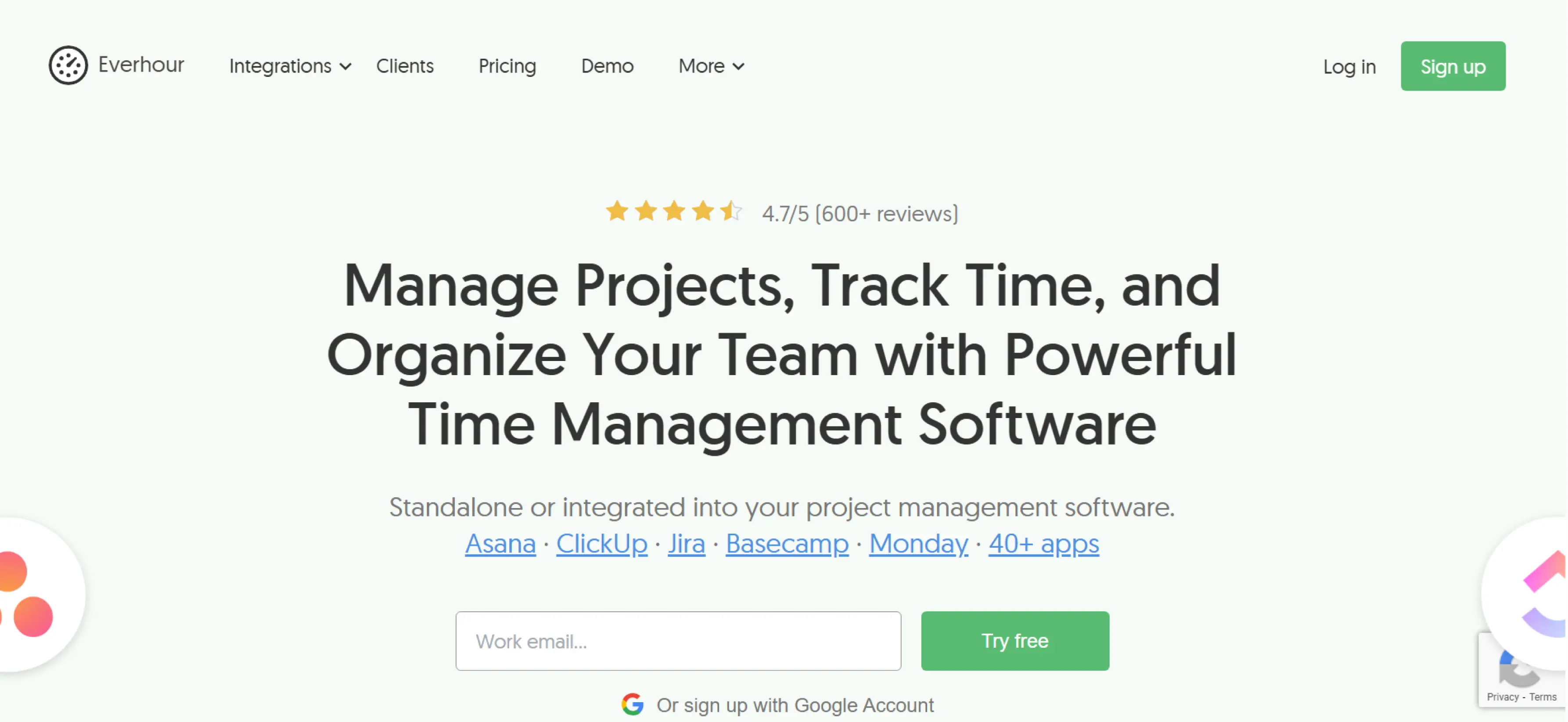
Everhour is a time tracking/project management software that can be integrated with other platforms such as Asana, Trello, Jira, and ClickUp, so users can log their time directly in those tools. It allows manual entries and timer-based entries, expense tracking, invoicing, and project budgeting with alerts. The platform also offers team dashboards for monitoring capacity, resource use, and project progress, with features designed to support small to mid-sized teams.
Key Features
- Team management capabilities enable tracking of employee capacity, hours, and profitability of the project as a whole to manage resource allocation.
- Reporting can be customized to give real-time information on time spent and project data to aid in decision-making among teams.
- Budgeting tools help manage project costs effectively by setting spending limits and tracking progress against financial goals.
- Invoicing capabilities enable accurate billing by generating invoices directly from logged time entries, reducing manual calculations and saving time.
| Pros | Cons |
|---|---|
| User-friendly and easy to navigate | Manual timer stop/start can lead to missed time |
| Accurate tracking against projects and client hours | Reports can be confusing or need manual adjustments |
| Seamless integration with Asana, Basecamp, Trello, Xero, Notion, and more | Some features lack polish or feel incomplete |
| Browser extension simplifies time logging for freelancers |
Pricing
- Monthly : Free - $0
- Team : $10
- Yearly: Free - $0
- Team : $8
Ratings
- G2: 4.7
- Capterra: 4.7
12. Desk Time
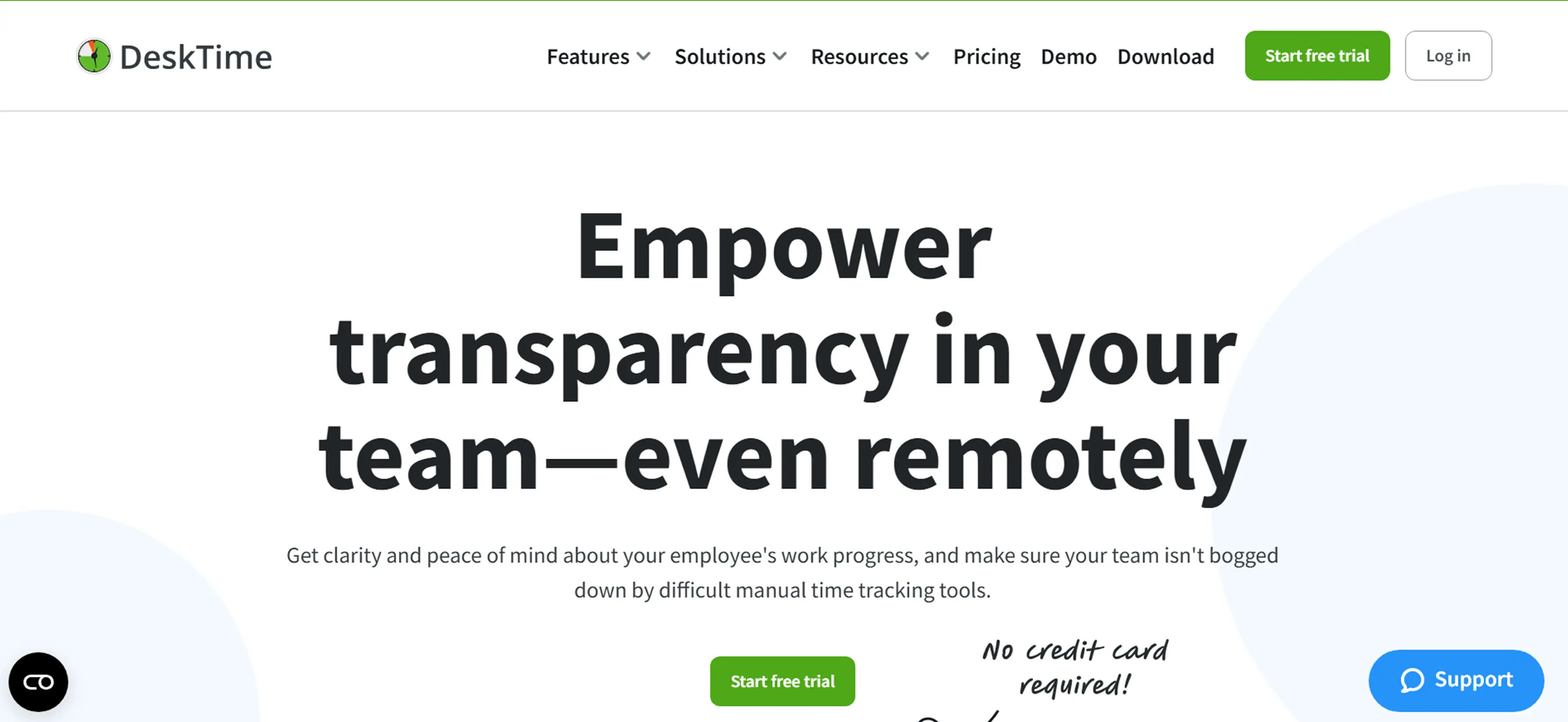
DeskTime is a time-tracking and productivity monitoring software that automatically runs in the background on Windows, macOS and Linux computers. It logs active vs. idle time, tracks usage of apps and websites, and periodically captures screenshots to help visualize workflow patterns.
Users appreciate its ease of setup and automated tracking, though some note occasional confusion over display complexity and privacy concerns related to screenshot monitoring
Key Features
- Project tracking offers comprehensive information on the amount of time allocated to every job or project and enhances project planning and resource allocation.
- Optional screenshots may be activated at the team or individual level and capture the screen activity for every 5, 10, 15, or 30 minutes to ensure accountability and visibility.
- Productivity calculation helps identify your most productive employees and spot inefficiencies by analyzing user behavior and activity levels.
- URL & App tracking allows you to monitor websites and applications your team accesses throughout the day, offering visibility into digital activity.
| Pros | Cons |
|---|---|
| Tracks daily work routines and time spent on tasks. | Some users feel discomfort with activity monitoring. |
| Boosts productivity through automatic time tracking and performance data. | More expensive than similar tools, especially for mid-size teams. |
| Useful for remote work and multi-location employee monitoring. | Occasional inaccuracies in recorded hours. |
| Easy integration with project tools, intuitive and easy to use. |
Pricing
- Monthly : Free - $0
- Team : $10
- Yearly: Free - $0
- Team : $8
Ratings
- G2: 4.7
- Capterra: 4.7
13. Clockify
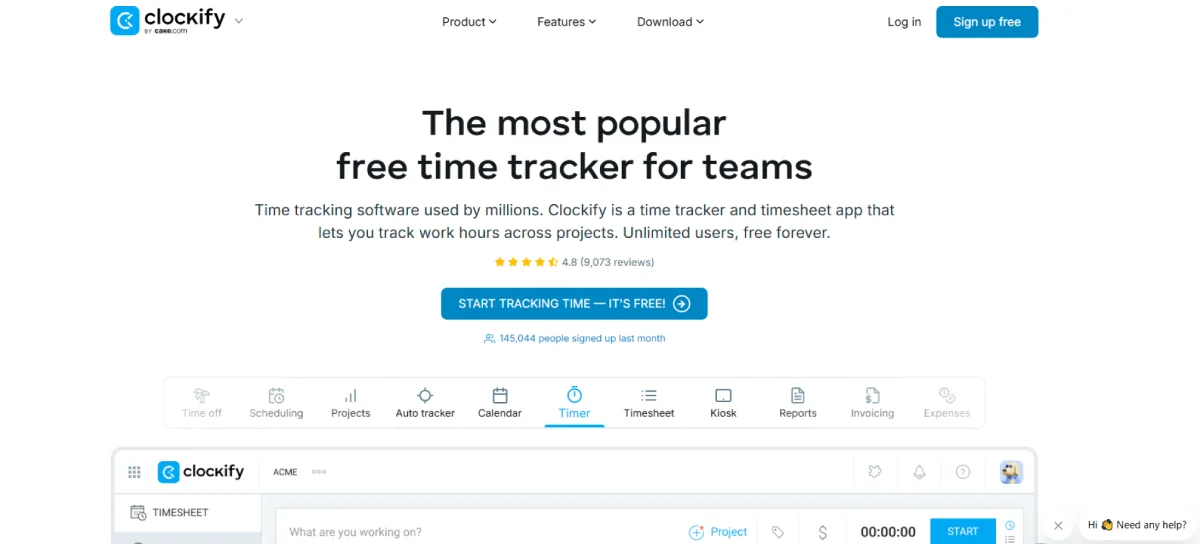
Clockify is a cloud-based time tracking and attendance tool that supports manual and automatic time logging across web, desktop, and mobile devices. It allows tracking time on projects, tasks or clients, and provides useful features such as idle time notifications, a focus timer and location tracking . Clockify also includes features for making reports, setting budgets, creating invoices, and approving timesheets, making it a simple and flexible option for teams to manage their work hours.
Key Features
- Reporting gives information on who did what, total hours and overall team productivity, and detailed time and earnings data, which can be exported.
- Time tracking reveals how time is utilized and what tasks or projects your team is currently engaged in to manage tasks better.
- Hourly rate settings allow you to calculate costs, earnings, and profits based on time worked, improving financial visibility and budgeting.
- Location tracking enables you to monitor visited job sites and review routes taken by your team, supporting on-site work verification and planning.
| Pros | Cons |
|---|---|
| Intuitive and user-friendly interface with minimal learning curve | Lacks reminder notifications and break alerts |
| Seamless time tracking and easy project/task management | UI can feel outdated or glitchy at times |
| Integration with tools like Jira, Trello, and Asana | Inconsistent mobile app performance and syncing delays |
| Helpful browser extension and mobile accessibility |
Pricing
- Standard : $ 5.49 per seat/month billed annually
- Pro : $ 7.99 per seat/month billed annually
- Enterprise: $ 11.99 per seat/month billed annually
Ratings
- G2: 4.5
- Capterra: 4.8
How to Select the Right Software for Your Team
1. Identify Your Team’s Needs and Pain Points
It is worth taking time to evaluate the exact situation your team is in before investigating software solutions. Are projects being delayed? Is communication decentralized due to many platforms? Being aware of these daily challenges can assist in determining which features are indeed necessary. Discuss with various team members to get diverse views and chart out the areas of inefficiencies. This preliminary measure will guarantee that the software you select actually addresses real issues, not merely introducing another tool to the mix.
2. Set Clear Objectives and Success Criteria
After identifying the requirements of your team, define measurable objectives that the software will help you meet. Regardless of whether it involves faster turnaround times, better task visibility, or more collaboration, a clear objective will enable you to assess potential tools more efficiently. Success criteria also help justify the investment later, if a tool improves delivery time by 20% for you then, it’s easier to quantify its impact.
3. Check Integration and Compatibility with Existing Tools
No software operates in isolation. The right tool must be able to fit into your current tech stack, email, communication apps, CRMs, file storage, and other platforms. Poor integration can lead to duplicated efforts, lost data, and workflow disruptions. Prioritize solutions that offer native integrations, open APIs, or plugins, so your team can transition without having to overhaul their entire setup.
4. Evaluate Usability and Team Adoption
The most feature-packed software is useless when your team cannot easily use it. Choose platforms that have clean interfaces, easy navigation, and a minimal learning curve. Identify tools that have free trials or demos to allow team members to experiment with them. Pay attention to onboarding resources, training support, and user feedback, because adoption is just as important as capability.
5. Balance Cost with Long-Term Value and Scalability
Do not only compare the prices on the tags, look at the value in the long term. An affordable system that does not offer essential functionalities or fails to grow with your organization will end up being more expensive in the long term. Look for flexible pricing models, upgrade paths, and strong customer support. Ideally, the software should serve your team now and grow with you in the future without requiring another major switch.
Final Thoughts
Picking the right time tracking tool can really improve how your team works. If Jibble doesn’t meet all your needs, it makes sense to look at other choices. This list of Jibble alternatives gives you several great options, each with different features to fit different teams. Now that you know what’s available, try a few, see what works best, and choose the one that makes your team’s work easier and more efficient.
Frequently Asked Questions
Many platforms include features like project management, invoicing, payroll, and productivity tracking. If your team is growing, pick a tool that does more than just track time.
Begin by exporting your current time data and then test the new tool on a small number of people. The majority of platforms provide a step-by-step guide or customer service to facilitate the transition.
Most tools are designed to be user-friendly, but a quick walkthrough or short onboarding session can help your team get the most out of it. Look for platforms with good tutorials and support.
Key features to consider include time tracking (manual and automatic), project/task management, employee scheduling, reporting, mobile access, and integrations with tools you already use (like Slack, Trello, or payroll software).
Here are Some Related Articles You may Find Interesting
Top 10 Time Doctor Alternatives for Better Time Tracking
Not satisfied with Time Doctor? Check out the Top 10 Time Doctor Alternatives to find suitable solutions for time tracking and team management requirements.
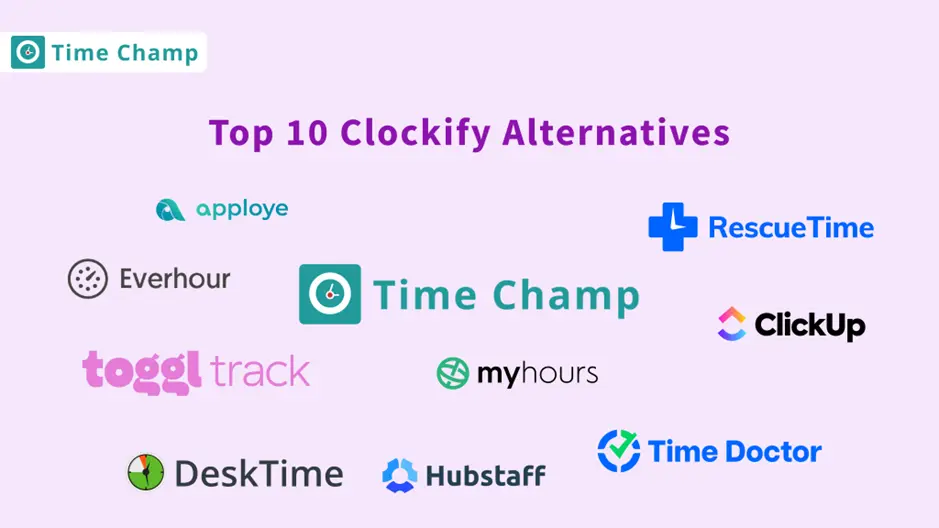
Top 10 Clockify Alternatives for Efficient Time Management
Looking beyond Clockify? Compare the top 10 Clockify alternatives for improved time tracking, boosted team productivity, and project and workflow management.
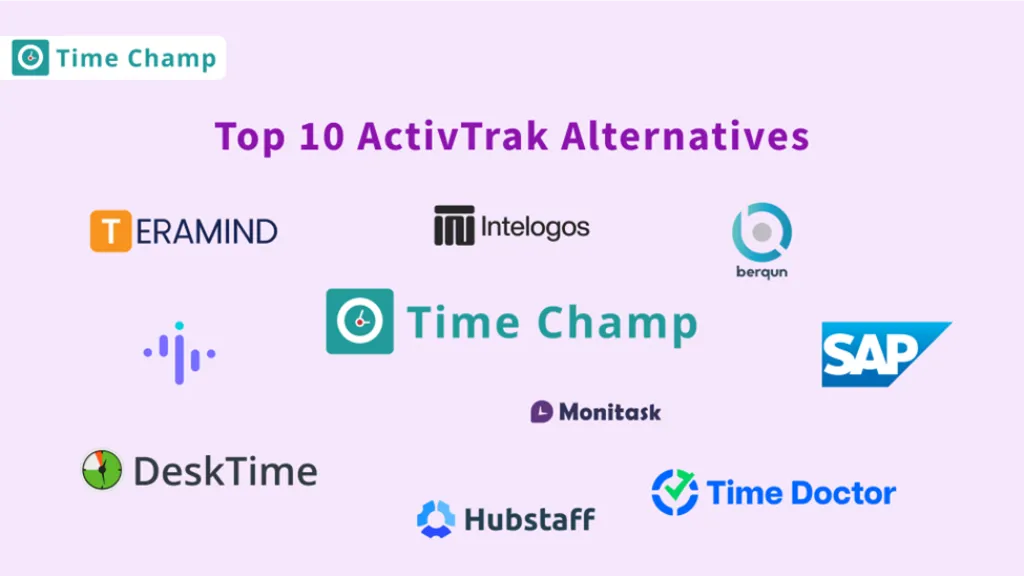
Top 10 Alternatives to ActivTrak For Smarter Tracking
Looking for ActivTrak alternatives? Explore the best options that can enhance productivity, improve time tracking, and support remote teams effectively.
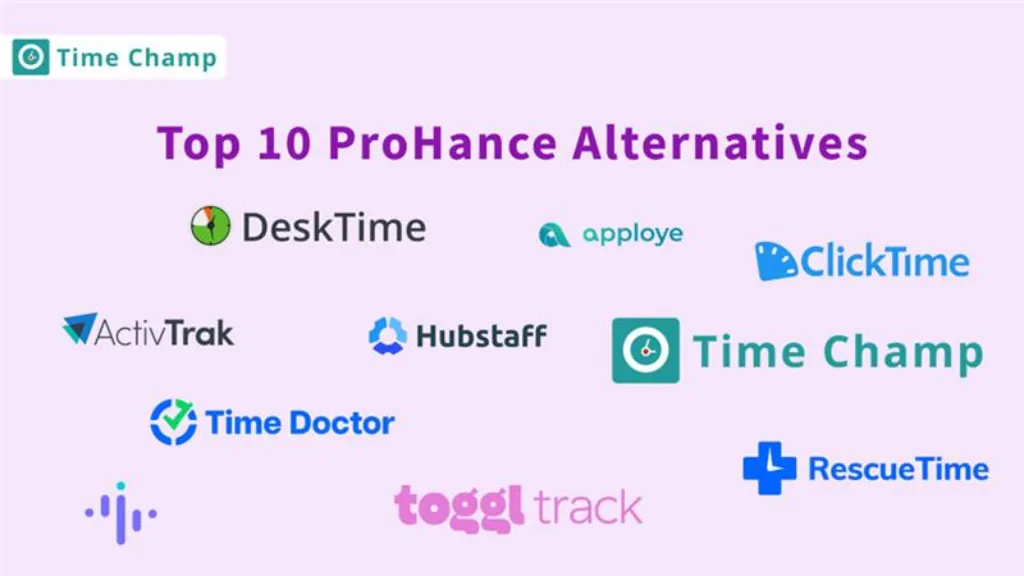
Top 10 ProHance Alternatives for Better Workforce Analytics
Looking for the best ProHance alternatives? Find out the top 10 ProHance alternatives, perfect for optimizing team performance and operational visibility.
Top 11 Flowace Alternatives for Smarter Time Tracking
Find the top 11 Flowace alternatives with an easier setup, better features with fair pricing, and flexible tools for remote and hybrid teams.
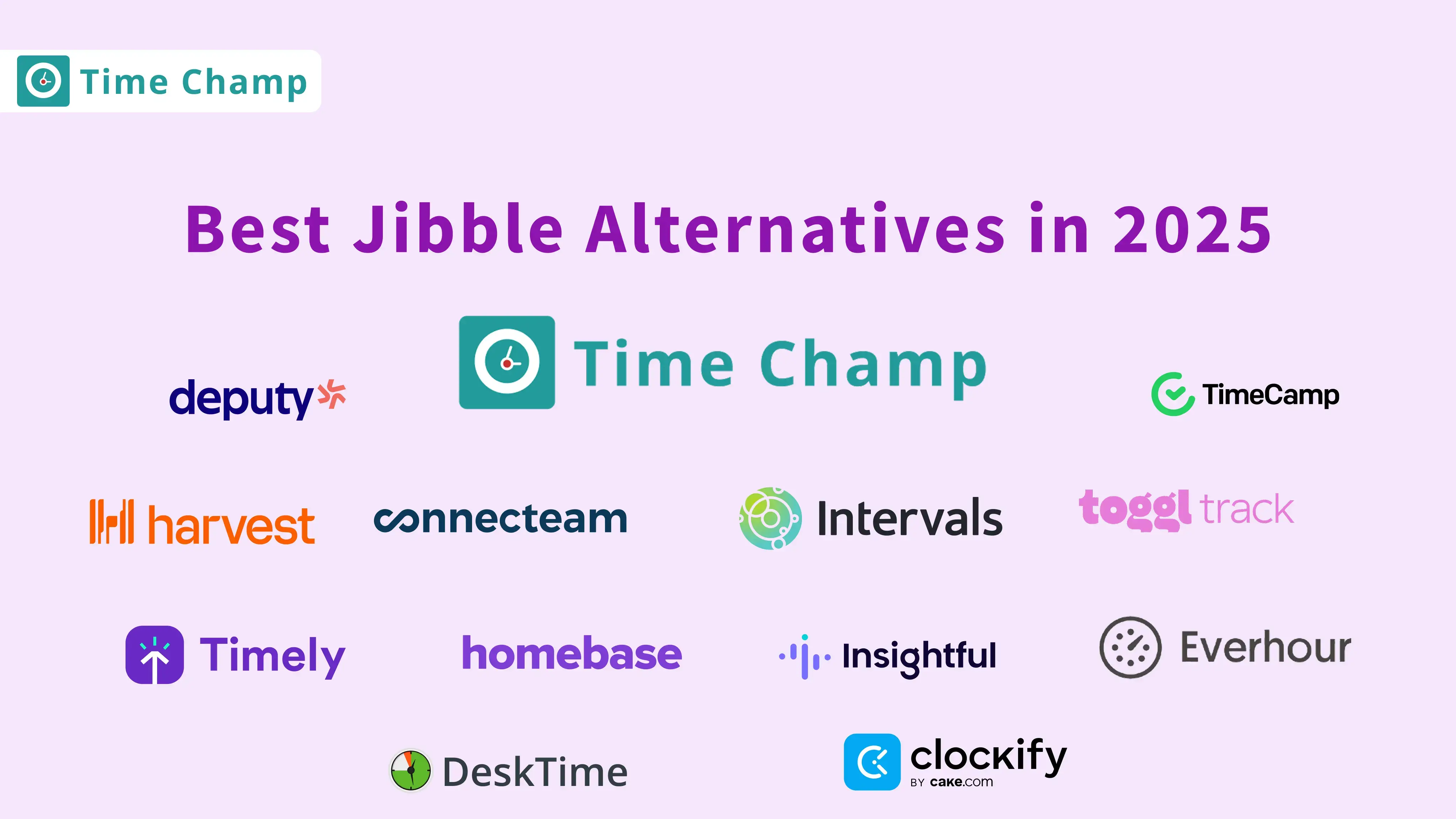
10 Best EmpMonitor Alternatives for Efficient Team Management
Explore the top 10 EmpMonitor alternatives to boost team productivity, streamline monitoring, and manage your workforce with ease in 2025.


